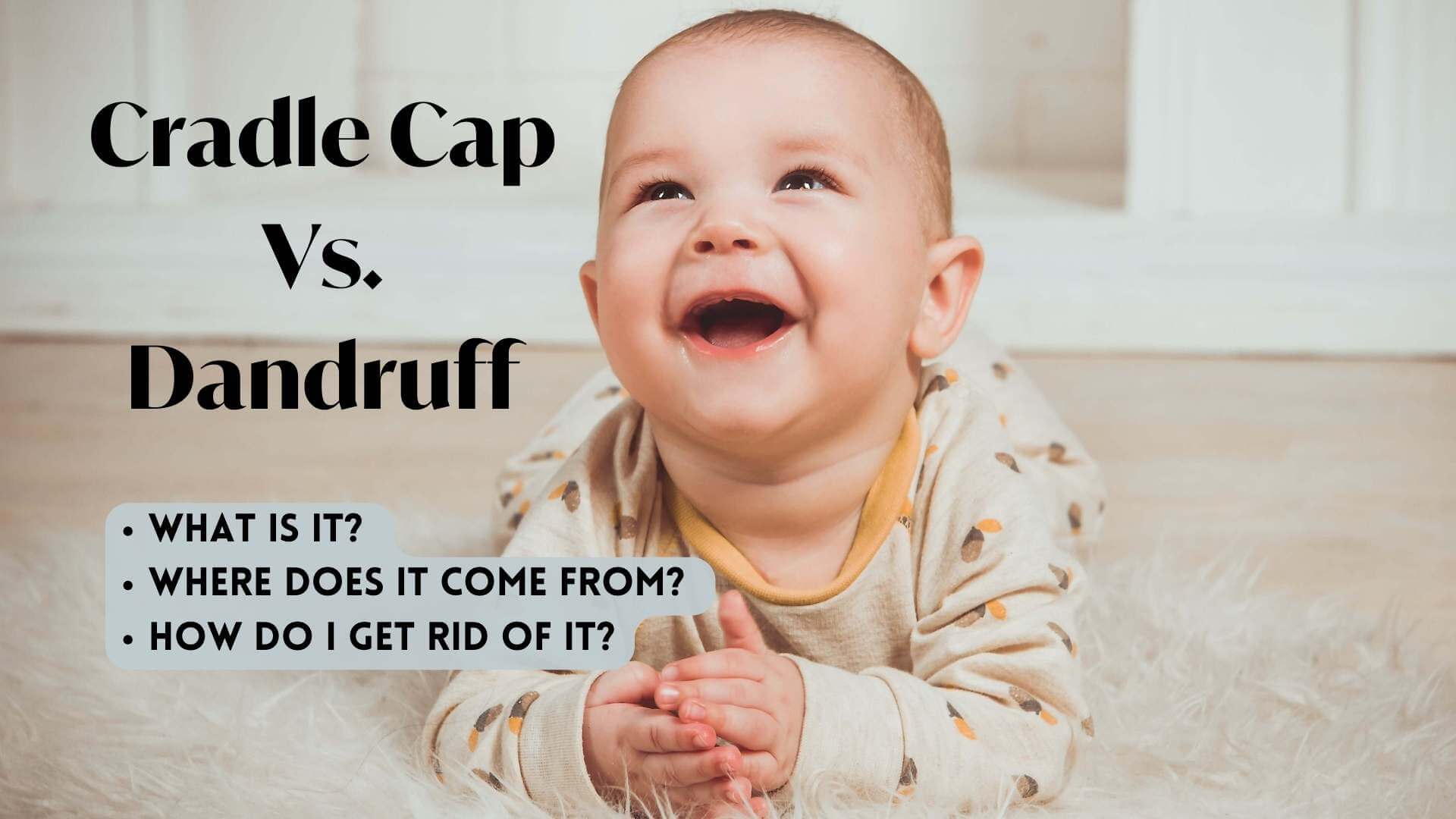Symptoms, contributing factors and caring for it- Everything you need to know about Cradle Cap.
Curious about your hair type? Take our curly hair quiz here.
What Is Cradle Cap?
Commonly known as Cradle Cap, is a common skin condition that affects young babies.
Its medical term ‘Infantile Seborrheic Dermatitis’ appears as a thick, yellow or light brown ‘crust’ on the baby's scalp.
While it might look concerning to new parents, Cradle Cap in infants is generally harmless. In fact, typically babies over three months old will have grown out of Cradle Cap. The good news is, in the meantime, there are simple ways to minimise the symptoms.
Signs & symptoms
If your baby has cradle cap, you might notice the following symptoms:
- Yellowish, oily, or waxy scales or flakes, primarily on the scalp, but occasionally on the eyebrows. It can often present as a thick ‘crust’ layering the scalp.
- Skin redness, which can occur if Eczema develops beneath the areas affected by cradle cap.

Caring for Cradle Cap
Cradle cap often improves on its own without requiring any specific treatment. The Royal Childrens Hospital in Melbourne recommends specific treatments for Cradle Cap. We’ve listed them below, however it's always best to consult your health practitioner before attempting any treatments.
- Soften the crusty patches by applying a gentle moisturising cream or lotion to the affected area of your baby's scalp. The following day, wash their hair with baby shampoo. While shampooing, use a soft brush (such as a new, soft toothbrush or a baby brush) to gently remove the loosened crusts. Repeat this process daily until the scalp appears clearer. Be careful not to irritate the scalp or remove any flakes that aren't loose.
- If the condition doesn't improve, consider using a mild anti-dandruff shampoo, but limit its use. These shampoos can be drying and may irritate a baby's delicate skin, so use them cautiously. Also, ensure the shampoo does not get into your baby’s eyes.
- Emollients: Applying baby oil or natural oils like coconut or almond oil before shampooing can help soften the scales. Hush Nourishing Oil is the perfect combination of organic and natural ingredients that will hydrate and soften your babies scalp. Jojoba, sunflower and grape seed oil are just a few nourishing ingredients that will help create your bugs scalp- Caution: Always do a small test patch before putting anything on your babies delicate skin to check for reactions.
Keep in mind that cradle cap might recur, as the sebaceous glands can continue to produce excess oil for several months. If the cradle cap returns, you can repeat the treatment as necessary.
“While treating cradle cap, be gentle. Avoid picking at the scales, as this can cause infection.”

Cradle Cap Vs. 'Baby' Dandruff
Dandruff gets a pretty bad rap, and sometimes with good reason! It’s hard to control, get rid of, and is incredibly misunderstood! While Cradle Cap may appear similar to dandruff it’s good to remember, they are two different conditions. Cradle Cap is often referred to as baby dandruff- however there really isn't such a thing.
Dandruff usually occurs during puberty or later in a child's development. confusing the two is common - and the key difference lies in the look of the flakes.
- Dandruff is usually dryer and Cradle Cap is greasier.
- Dandruff flakes off the skin, however Cradle Cap sticks to the skin.
Both are often a result of the skin's reaction to excess sebum. Dandruff, also referred to as 'adult dandruff', tends to be characterised by a flaky, dry scalp. Cradle Cap, on the other hand, is marked by thicker, oilier scales or crusts.
For more information on dandruff and scalp health, our blog ‘Hair health starts below the roots’ has everything you need to know about dandruff, treatment and preventative care.
What Causes Cradle Cap?
The exact cause of Cradle Cap is unknown, but it's believed to be linked to hormonal changes that stimulate oil glands in the skin. There’s a theory that maternal hormones still circulating in the baby’s system can contribute to excessive sebum production, leading to Cradle Cap.

Symptoms and Diagnosis
Common symptoms of Cradle Cap include:
- Patchy scaling or thick crusts on the scalp
- Oily or dry skin covered with flaky white or yellow scales
- Mild redness in some cases
Diagnosis is usually based on a visual examination. In most cases, a GP or community health nurse’s observation is sufficient for diagnosis. If the condition seems severe, your doctor might refer to a paediatrician or dermatologist to conduct further tests to rule out other skin conditions.
** If you’re worried about your baby's Cradle Cap, always check with your medical practitioner or community health nurse.
When To See A Doctor
Cradle Cap is usually not serious, however if you’re worried seek medical advice.
If:
- The condition spreads to other areas like the face or more sensitive areas.
- The affected skin appears red, swollen, or feels warm.
- There’s excessive hair loss.
- The Cradle Cap persists beyond the first year.

Does My Baby's Hair Type Determine If They Will Have Cradle Cap?
The short answer is no. The Jury is still out on the exact cause of Cradle Cap.
As most babies are born without much hair at all, it's unlikely determined by your baby's hair type! However, as your child grows, their predetermined hair type will influence the way their hair behaves and it’s ability to absorb and retain moisture, sometimes, resulting in adult dandruff.
Naturally curly hair can be more prone to dandruff because of its unique spiral structure and inability to evenly distribute the natural oils produced by the scalp.
This affects the efficiency of the hair's hydrolipidic film, which is crucial for scalp health. As a result, the protective barrier function of the scalp is not as effective in people with naturally curly hair.
Preventative Measures
While there's no surefire way to prevent Cradle Cap, regular scalp care can help reduce the risk. Keeping the baby’s scalp clean and moisturised is key. Also, limit the use of hats and other tight headwear that can trap heat and sweat.
Myths & Misconceptions
There are many myths and misconceptions around Cradle Cap; Lets clear them up!
Myth: Cradle Cap is contagious.
- BUSTED! Cradle cap is not contagious. It's a common condition in infants, characterised by scaly, crusty patches on the scalp, and it is not caused by any infectious agent. Its occurrence is related to factors like skin sensitivity and oil production, not by spreading from one individual to another.
Myth: Cradle Cap is caused by poor hygiene.
- BUSTED! Cradle cap is not a result of poor hygiene. It occurs in babies regardless of how well they are cared for. The condition is thought to be linked to overactive sebaceous glands in the baby's skin that produce an excess of oil, possibly due to maternal hormones still in the baby's system.
Myth: Cradle Cap is a form of dermatitis.
- TRUE! Cradle cap is considered a form of seborrheic dermatitis that specifically affects infants. While it shares some similarities with other forms of dermatitis, like red and scaly skin, it is a distinct condition primarily affecting the scalp of newborns and typically resolving on its own without treatment.
Myth: Naturally curly hair is more prone to Cradle Cap.
- Busted! Naturally Curly Hair can be susceptible to dandruff as your baby grows up, however Cradle Cap is purely an infantile condition that in most cases clear up after 3 months. Regardless of whether your child has straight hair, or naturally curly hair, there are many contributing factors to the development of Cradle Cap or dandruff.

Myth: Babies will grow out of cradle cap.
- TRUE! In *most* cases babies do outgrow Cradle Cap. It usually resolves on its own within a few months, though it can last longer in some cases. There's usually no need for medical treatment. **If the Cradle Cap is severe, lasts longer than 1 year or seems to be causing discomfort to the baby, medical intervention might be necessary.
Myth: Cradle Cap will eventually turn into dandruff.
- BUSTED! Cradle cap and dandruff are two different conditions, although they may appear similar. Cradle Cap typically resolves in infancy and does not necessarily lead to dandruff later in life. Dandruff, typically starting around puberty, is associated with an entirely different set of causes and factors than Cradle Cap.
Cradle Cap is a common, and usually harmless condition experienced by many newborns and infants.
Differentiating it from a type of dandruff is important for appropriate care.
With gentle treatment and regular scalp care, Cradle Cap typically resolves with no lasting issues. Remember, We are not medical experts or health professionals and when in doubt, consulting a paediatrician is always the best course of action.
LOHY xx




How To Sleep With Curly Hair: Simple Strategies For Frizz-Free Mornings
7 Steps To Flawless Blonde Curly Hair